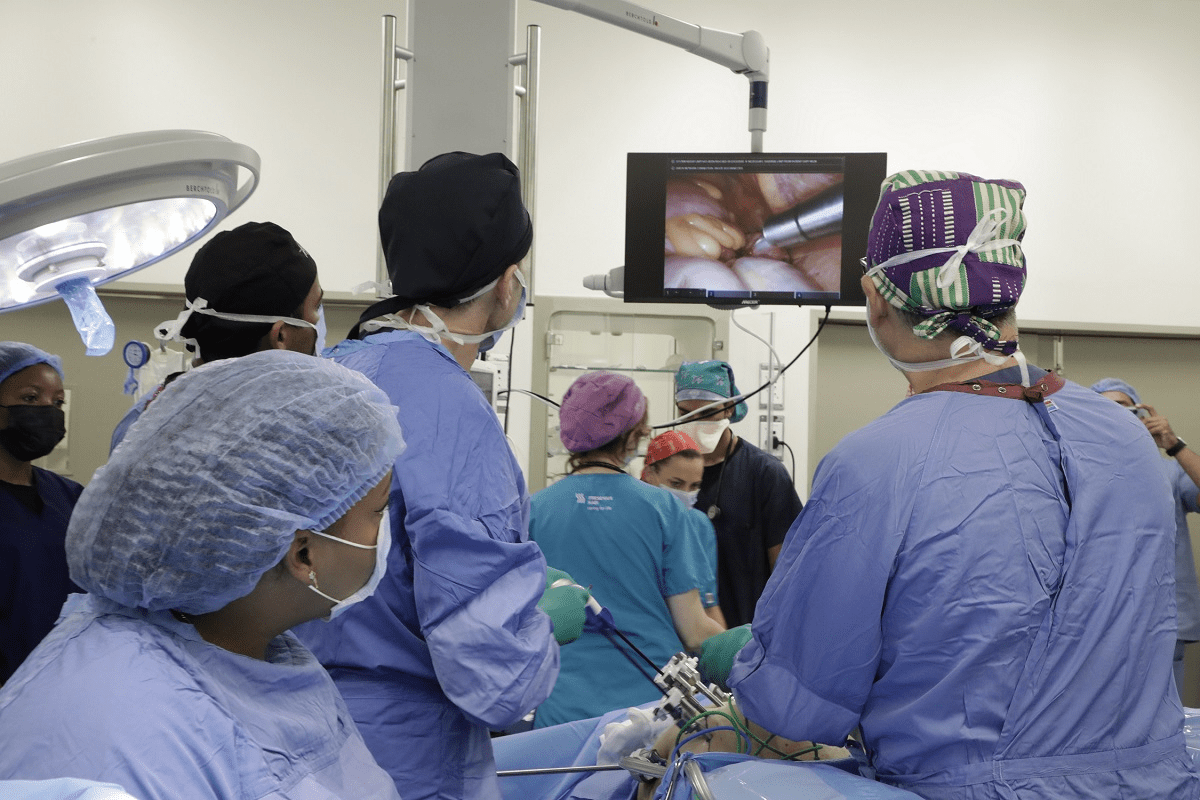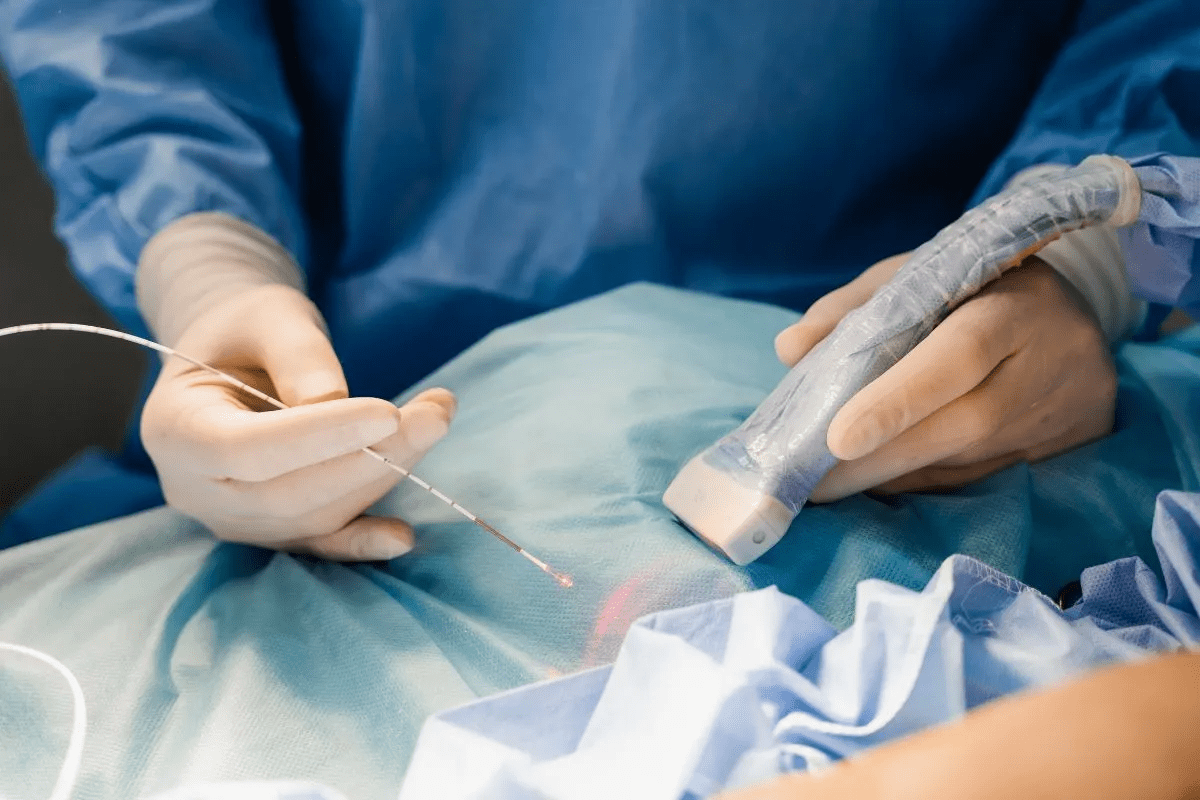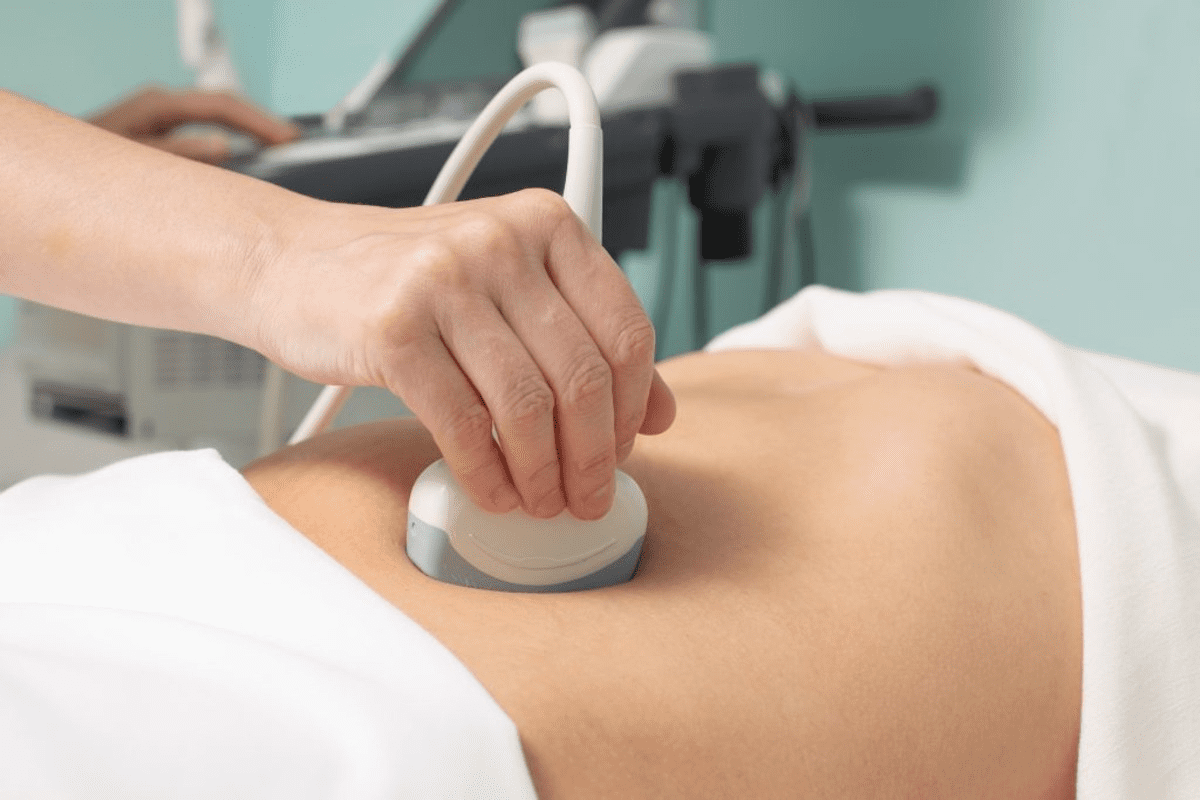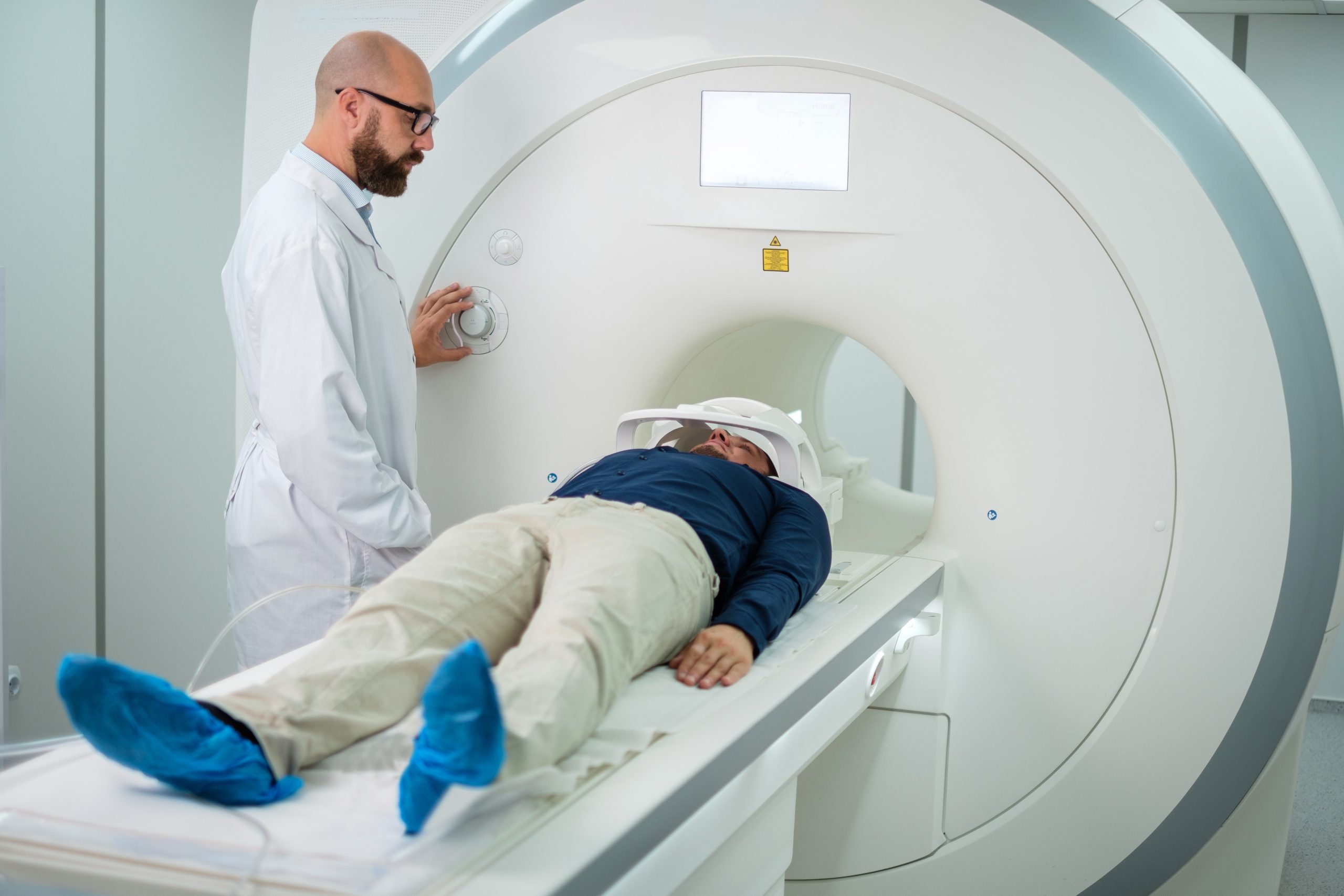Last Updated on November 26, 2025 by Bilal Hasdemir

Getting a diagnosis of an aortic aneurysm can feel scary. But, learning about EVAR surgery can offer hope. At Liv Hospital, we focus on you and use the latest in vascular care to help you get better.
EVAR aortic aneurysm repair is a new, less invasive way to treat aortic aneurysms. It uses a stent graft to strengthen the aorta, lowering the chance of rupture.
Finding the right treatment can be tough. Our team is here to help you understand EVAR. We’ll explain its benefits and what you can expect during the procedure.
Key Takeaways
- EVAR is a minimally invasive procedure for treating aortic aneurysms.
- It involves inserting a stent graft to reinforce the weakened vessel wall.
- EVAR reduces the risk of aneurysm rupture without open surgery.
- Liv Hospital prioritizes patient-focused care and advanced vascular treatments.
- Our team guides you through the EVAR procedure and its benefits.
What Are Aortic Aneurysms and Why Are They Dangerous?

The aorta is the main artery that carries blood from the heart to the rest of the body. It can develop a serious condition called an aortic aneurysm. This happens when a part of the aorta weakens, causing a bulge that can burst and lead to severe bleeding inside the body.
Aortic aneurysms are classified based on their location and characteristics. Knowing these differences is key to choosing the right treatment.
Types of Aortic Aneurysms
There are several types of aortic aneurysms, including:
- Abdominal Aortic Aneurysms (AAA): These occur in the abdominal section of the aorta and are the most common type.
- Thoracic Aortic Aneurysms (TAA): These occur in the chest area and can involve the aortic root, ascending aorta, or descending aorta.
- Thoracoabdominal Aortic Aneurysms: These aneurysms span across both the thoracic and abdominal regions of the aorta.
Risk Factors for Developing Aortic Aneurysms
Several factors increase the risk of developing an aortic aneurysm, including:
- Smoking: Smoking is a significant risk factor, as it damages the aortic wall.
- High Blood Pressure: Hypertension can put additional stress on the aortic wall, increasing the risk of an aneurysm.
- Family History: Having a family history of aortic aneurysms increases an individual’s risk.
- Atherosclerosis: The buildup of plaque in the arteries can weaken the aortic wall.
Complications of Untreated Aneurysms
If left untreated, aortic aneurysms can lead to severe complications, most noticeably rupture, which is a life-threatening emergency. Other possible complications include:
- Dissection: A tear in the inner layer of the aorta, which can cause severe pain and further complications.
- Embolism: The release of blood clots or other debris from the aneurysm, which can block other arteries.
Understanding the risks and complications associated with aortic aneurysms highlights the importance of timely medical intervention.
EVAR Aortic Aneurysm Repair: The Fundamentals

Endovascular Aneurysm Repair (EVAR) is a big step forward in treating aortic aneurysms. It’s a less invasive option compared to traditional surgery. This method uses a stent graft to strengthen the aorta, stopping the aneurysm from getting worse or bursting.
Definition and Medical Terminology
EVAR is a procedure to fix abdominal aortic aneurysms (AAA) without open surgery. It’s called “endovascular” because it uses small incisions to reach the blood vessels. The stent graft helps keep the artery strong, preventing the aneurysm from growing or bursting.
Key terms in EVAR include “stent graft,” “catheter-based procedure,” and “endovascular repair.” Knowing these terms helps patients understand their treatment better.
History and Development of EVAR
The idea of EVAR started in the late 20th century. Vascular surgeons were looking for ways to treat aortic aneurysms without big surgeries. The first EVAR was done in the early 1990s, starting a new chapter in vascular surgery.
Over time, EVAR has improved a lot. Better stent grafts and imaging tools have made it more effective. Now, more people can get treated with EVAR.
How EVAR Differs from Traditional Open Surgery
EVAR is different from traditional surgery in many ways. The biggest difference is that EVAR is less invasive. It uses small cuts in the groin to reach the arteries, not big cuts in the chest or belly.
This method causes less damage to tissues, lowers the risk of problems, and means quicker recovery times. EVAR can also be done with local or regional anesthesia, which is safer than general anesthesia.
Learning about EVAR helps patients understand their options for treating aortic aneurysms. It’s all about knowing the basics, history, and how it compares to traditional surgery.
The EVAR Surgical Procedure Explained
EVAR surgery, or Endovascular Aneurysm Repair, is a complex method to fix aortic aneurysms. It’s a minimally invasive way to treat these conditions, making it safer than traditional surgery.
Pre-Surgical Evaluation and Planning
Before EVAR surgery, patients go through a detailed evaluation. They have CT scans and angiograms to find out about the aneurysm’s size and location. Our team picks the best stent graft for each patient based on these findings.
We also check the patient’s health and any risks that might affect the surgery or recovery. This careful planning helps us prepare for any challenges during the procedure.
Step-by-Step EVAR Technique
The EVAR surgery involves several important steps:
- Administering local or general anesthesia to ensure patient comfort.
- Making small incisions in the groin to access the femoral arteries.
- Inserting catheters and guidewires through the incisions to reach the aortic aneurysm.
- Using advanced imaging technology to guide the stent graft to the aneurysm site.
- Deploying the stent graft to exclude the aneurysm from blood flow, preventing further expansion and rupture risk.
Types of Stent Grafts Used in EVAR
There are different stent grafts for EVAR, each for various patient needs. The right stent graft depends on the aneurysm’s size, location, and the patient’s blood vessels.
| Stent Graft Type | Description | Key Features |
| Zenith | A modular stent graft system | High flexibility, precise deployment |
| Endurant | Designed for challenging anatomies | Strong radial force, ease of use |
| Excluder | Low-profile design for smaller access vessels | Minimally invasive, reduced risk of complications |
Understanding EVAR surgery, from evaluation to stent graft types, helps patients see the detailed care in treating aortic aneurysms.
Candidates for EVAR: Who Qualifies for This Procedure?
Not all patients with aortic aneurysms are good candidates for EVAR. A detailed check is needed to see if they qualify. The decision to use EVAR depends on several factors. These include the patient’s body shape, health history, and any issues that might make EVAR risky.
Anatomical Requirements for Successful EVAR
For EVAR to work well, some body requirements must be met. These are:
- Aneurysm size and location: The aneurysm must be the right size and in the right spot for the stent graft to be safely placed.
- Aortic neck characteristics: The aortic neck needs to be long enough and wide enough for a good seal.
- Iliac artery access: The iliac arteries must be big enough and not too twisted for the stent graft to pass through.
CT angiography is key in checking these body parts and planning the EVAR procedure.
Medical Considerations and Contraindications
Some health issues can make EVAR not suitable for a patient. These include:
- Severe kidney disease: People with serious kidney problems might face more risks from the contrast used in EVAR.
- Bleeding disorders: Those with big bleeding problems need special care during EVAR.
- Allergies to contrast agents: Patients allergic to contrast agents might need special treatment or other imaging methods.
We look closely at each patient’s health history to find any issues that might make EVAR risky. Then, we plan how to reduce those risks.
High-Risk Patients Who Benefit from EVAR
EVAR is very helpful for patients at high risk for open surgery. These include:
- Elderly patients: Older patients with many health problems might find EVAR’s minimally invasive nature helpful.
- Patients with severe cardiac or pulmonary disease: EVAR is a safer choice for those with serious heart or lung issues.
- Patients with previous abdominal surgery: EVAR is safer for those who have had complex surgery in the abdomen.
By choosing the right patients and customizing EVAR for them, we can offer a safe and effective treatment for many with aortic aneurysms.
Benefits of Endovascular Aortic Aneurysm Repair (EVAR)
EVAR has changed how we treat aortic aneurysms. It’s a less invasive method than traditional surgery. This leads to better results, fewer complications, and quicker healing.
Minimally Invasive Approach Advantages
The minimally invasive nature of EVAR is a big plus. It doesn’t need a big cut like open surgery does. Instead, it uses small incisions in the groin. This causes less damage and pain, and lowers the chance of problems.
Also, EVAR lets doctors place the stent graft more accurately. This makes the procedure more effective. It also means patients have a smoother, less painful recovery.
Reduced Hospital Stay and Recovery Time
People who get EVAR usually stay in the hospital less than those who have open surgery. This is because EVAR is less invasive. It leads to fewer complications and a quicker recovery.
The recovery time for EVAR is also shorter. This means patients can get back to their lives sooner. It’s great for those who are active or have a lot of responsibilities.
Lower Immediate Mortality Rates
EVAR has lower immediate mortality rates than open surgery, which is good for high-risk patients. The lower risk of complications during surgery makes EVAR safer.
By reducing the risk of immediate complications, EVAR is a safer choice for many. This is key for those who are older or have health issues.
Potential Risks and Complications of EVAR Vascular Surgery
It’s important for patients to know about the risks of EVAR surgery. This treatment is a big step forward for aortic aneurysms. But, it can have some complications.
Short-Term Complications
Right after surgery, patients might face bleeding, infection, or reactions to the dye used. Close monitoring is key to avoid these issues.
Some might get minor problems like groin pain or swelling. These usually go away by themselves. But, serious complications like big bleeding or graft moving are rare but need quick action.
| Complication | Description | Frequency |
| Bleeding | Hemorrhage at the access site or within the aneurysm sac | Rare |
| Infection | Infection at the access site or of the stent graft | Uncommon |
| Reaction to Contrast Dye | Allergic reactions or kidney injury due to the contrast dye | Uncommon |
Long-Term Concerns
Long-term, EVAR surgery might lead to endoleaks, stent graft issues, or aneurysm growth. Regular surveillance helps catch these problems early.
Endoleaks are a big worry because they can make the aneurysm sac pressurize and grow or burst. Types of endoleaks vary, and how they’re handled depends on the type and how bad they are.
Understanding Endoleaks and Other EVAR-Specific Issues
Endoleaks are divided into types based on their cause. Knowing these types is key to managing them well.
- Type I: Leak at the ends of the stent graft
- Type II: Retrograde flow from branches into the aneurysm sac
- Type III: Leak through the fabric of the stent graft or between modular components
- Type IV: Flow through the graft due to porosity
- Type V: Endotension or continued sac expansion without visible leak
Dealing with these issues might need more surgeries. This shows why lifelong surveillance is so important for EVAR surgery patients.
Recovery and Post-EVAR Surveillance
Understanding the recovery process and post-EVAR surveillance is key for patients. It’s vital for your treatment plan. We’ll guide you through this important phase.
Hospital Stay and Immediate Recovery
After EVAR surgery, patients usually stay in the hospital for a few days. Medical staff watch over them closely. They manage pain and look for any complications.
Because EVAR is minimally invasive, recovery is faster. Most patients can get back to normal activities sooner than with open surgery.
Activity Restrictions and Return to Normal Life
Recovery from EVAR is quicker, but there are activity limits. Patients should avoid heavy lifting and bending at first. As they heal, these limits are eased, and they can get back to their usual life.
It’s important to follow your healthcare team’s advice for a smooth recovery. A study on the National Center for Biotechnology Information website highlights the need for careful post-operative care and follow-up.
Lifelong Surveillance Requirements
Post-EVAR care includes lifelong surveillance. Patients need regular CT scans to check the stent graft. This helps catch any problems early.
Following the recommended surveillance schedule is key. It helps prevent complications and ensures the stent graft works well. Our team is here to support you every step of the way.
EVAR for Abdominal Aortic Aneurysm: Special Considerations
Endovascular Aneurysm Repair (EVAR) has changed how we treat abdominal aortic aneurysms (AAAs). It’s a less invasive method. We’ll look at the special things to think about when using EVAR for AAA, like challenges, success rates, and new ideas in this area.
Anatomical Challenges in AAA Repair
One big challenge in EVAR for AAA is dealing with the complex aorta. Accurate preoperative planning is key to make sure the stent graft fits right. We need to think about the aneurysm’s size, shape, and where it is, plus the patient’s blood vessel health.
Dealing with angulated or tortuous vessels can make things harder. We need special skills and tools for this. Also, making sure the aneurysm is sealed well is important to avoid leaks and ensure the repair lasts.
Success Rates for AAA EVAR
Many studies show EVAR is good for treating AAAs. High technical success rates have been found. Many patients do better and have less problems than with old-fashioned open repair.
The success of EVAR for AAA depends on many things. These include who gets treated, how well the aorta looks, and the skill of the medical team. Keeping an eye on patients after treatment is key to catch any problems early and make sure the repair works well for a long time.
Latest Innovations in AAA EVAR Techniques
The field of EVAR is always getting better, with new tech and methods coming out. New stent graft designs and better ways to put them in are being made. These help with tricky aorta shapes and make the procedure more successful.
We’re moving towards more personalized and precision medicine in EVAR. This means treatments that fit each patient’s needs and body. These new ideas should make EVAR even better for treating AAA.
Conclusion
Endovascular Aneurysm Repair (EVAR) is a big step forward in treating aortic aneurysms. It’s a less invasive option compared to open surgery. We’ve looked into the good and bad sides of EVAR for treating aneurysms, focusing on abdominal aortic aneurysms.
Research shows EVAR is safe and works well. It helps patients recover faster and lowers the risk of dying right after treatment. Knowing about EVAR helps patients make better choices for their health.
As medical tech keeps getting better, EVAR will become even more key in treating aortic aneurysms. We hope this detailed look at EVAR has given you useful info. It’s all about helping patients with aortic aneurysms.
FAQ
What is EVAR surgery?
EVAR stands for Endovascular Aortic Aneurysm Repair. It’s a new way to fix aortic aneurysms. A stent graft is used to strengthen the aorta, lowering the risk of rupture.
What are the benefits of EVAR compared to traditional open surgery?
EVAR is less invasive, leading to shorter hospital stays and quicker recovery. It also has lower immediate death rates. This makes it safer for many patients.
Who is a candidate for EVAR?
EVAR is for people with aortic aneurysms who fit certain criteria. It’s also for high-risk patients who can’t have open surgery.
What is the EVAR surgical procedure like?
First, there’s a pre-surgery check and plan. Then, a stent graft is put into the aorta through imaging. This graft strengthens the weak part of the aorta.
What are the possible risks and complications of EVAR?
EVAR is mostly safe, but there are risks. These include short-term and long-term problems, and issues like endoleaks. Knowing these risks helps patients make informed choices.
What is the recovery process like after EVAR?
After EVAR, patients stay in the hospital briefly. Then, they slowly get back to normal. They also need ongoing checks to make sure the graft works well.
How does EVAR treat abdominal aortic aneurysms (AAA)?
EVAR is a top choice for AAA because it’s less invasive and effective. It tackles specific challenges and uses new techniques for success.
What are endoleaks, and how are they managed?
Endoleaks happen when blood leaks into the aneurysm sac after EVAR. They’re watched closely and treated if needed to avoid more problems.
Is lifelong surveillance necessary after EVAR?
Yes, lifelong checks are key after EVAR. They help make sure the stent graft works well and catch any issues early.
References:
- Newton, L. E., et al. (2025). Imaging surveillance adherence after EVAR at Veterans Affairs hospitals: A national cohort study. JAMA Network Open, 8(3), e2833190. https://jamanetwork.com/journals/jamanetworkopen/fullarticle/2833190






